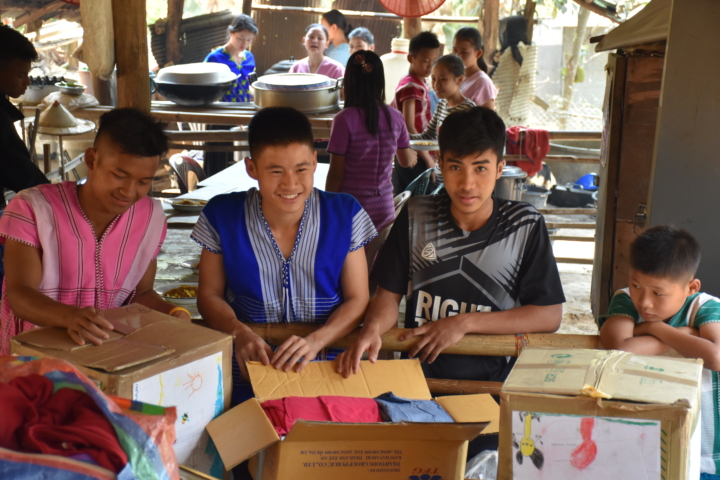At the Mae La Camp

By George Ritinsky.
Two days spent among the refugees, the poorest migrants, on the border between Thailand and Myanmar. An overwhelming experience that raises disturbing questions.
After each investigation, one of the reporters’ tasks is to put in order our photos, our ideas, and everything we found out after our last job. The rule is to be detached from everything we have seen, and this applies to all of us. Including myself. Actually, I find it impossible. Two days in the mountains between Thailand and Myanmar, where I also paid visit to the famous camp of Mae La a few years after my last visit, was one of those strong experiences that leave no one indifferent.
Mae La is one of the eight refugee camps (and a big one) that are still operational in Northern Thailand. Still today, it hosts about 45 thousand “locked up” people. In the last 10 years, my commitment in favor of refugees and migrants has been intense, but I cannot get used to their suffering, especially the one affecting children, who do no longer smile. In fact, in the camps the most frequent disorder is depression. It affects everyone, young and old alike. After fleeing Myanmar, after the hunger they suffered in the forest, often affected by dengue fever and malaria, these children hardly smile, even if they are now safe. Life in the camp is very hard. I cannot get used to those gazes that question me, every time, like an infinite ”why.” Every time I go through those dusty roads used by the refugees and I look at their huts, the only thing I can do is to remain silent, in a deep inner recollection. People, not things, inhabit them. Human beings, whose awful living conditions and total lack of comfort are incomprehensible and unacceptable to us.
You can only keep quiet, walk on and, literally, swallow the dust and some tears. I see a few hills covered with huts, where some “guests” have been living for decades, unable to go anywhere else, except returning to Myanmar. Mae La is a piece of land that was donated by the previous king Rama IX, Bhumibol Adulyadej, who for 70 years has been ruling over Thailand, commonly called “the land of free men.” Thailand has always faced the problem of citizens from neighbouring countries who entered illegally the territory of the Kingdom of Thailand – simply because they were unable to do otherwise.
Since 1988, starting from the day of the famous so-called “88 revolution” – when Aung San Suu Kyi found herself at the head of the student revolt -, the paradigm has completely changed. It is as if its frontiers, at a certain point in the history of the region, had been literally deleted, and thousands of people have crossed the border that separated Myanmar from Thailand to find a way out, in search of a chance to live, to avoid being slaughtered by the army of Myanmar. Since 1988, in fact, the refugee camps on the border between the two countries have been an example of reception and of the opportunity given to these people to continue their life and to hope for a better future. Thailand now welcomes immigrants mainly from Myanmar, Cambodia, Laos, Vietnam and – more recently – from Pakistan, India, and Nepal, all searching for a job, for a new Eldorado to start a new life, in view of a better future.
Thailand, in the last 10 years, has experienced a significant demographic decline and an alarming labour shortage, forcing the different governments to adopt new strategies to receive and regulate migration flows and to use them for services and industries, in which Thai citizens no longer want to work. Being in touch with migrants, you can easily perceive the fragility of their legal and human condition. An impressing fragility, all the more so when the subjects involved are children or young people. A health-care worker in Mae La told me that every day at least one child is born in the small clinic (one of many) in the camp where she works. Why do many young people still prefer to leave Myanmar and enter the Mae La camp today? Because education in Mae La is undoubtedly better than education in Myanmar. This, we could say, explains a lot; it tells a lot about the conditions in Myanmar today.
With a special permit valid for a few hours, I could visit my young friends and collect some of their dreams. For example, learning English, get a diploma from one of the schools in the camp, dreaming of a remote opportunity of finding a job in Thailand, in one of the many factories that are opening now in the economic zone with special status, right in Mae Sot. This was a smart political-economic decision aimed at attracting many foreign and local production plants to a mountain region, far from pollution controls and international safety standards, now in force in the rest of the country, and especially with an abundance of labor at half price compared to other regions and production areas in Thailand. The refugees in Thailand are a small part of the 58 million refugees in the world but, in my opinion, they can be very profitable for those in charge. We must not forget that while I am writing this article, more refugees or migrants joined the list that someone closed a few minutes ago: one every two seconds.
Coming down from the mountains of Mae La, I was talking to a friend, also a reporter, about how important it is not to forget about these people, but report to the rest of the world about them. Because their life is no less valuable than my life, our life, the life of all of us.
Source:
